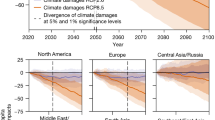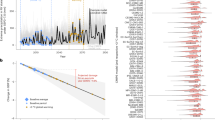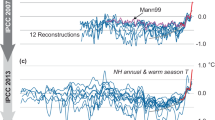Abstract
The atmospheric circulation controls how global climate change will be expressed regionally. Substantial circulation changes are expected under global warming, including a narrowing of the intertropical convergence zone1,2, a slow down and poleward expansion of the tropical circulation3,4, and a poleward shift of mid-latitude stormtracks and jets5,6. Yet, climate model projections of the circulation response to climate change remain uncertain7. Here we present simulations with two different aquaplanet climate models and analyse these simulations using the cloud and water-vapour locking method. We find that radiative changes of clouds and water vapour are key to the regional response of precipitation and circulation to global warming. Model disagreement in the response of key characteristics of the atmospheric circulation—the intertropical convergence zone, the strength of the Hadley circulation, and the trade winds—arises from disagreement between the models in radiative changes of tropical ice clouds and their coupling to the circulation. We find that cloud changes amplify a poleward shift of the extratropical jet, whereas water vapour changes oppose such a shift, but the degree of compensation is model-dependent. We conclude that radiative changes of clouds and water vapour are not only integral to the magnitude of future global-mean warming but also determine patterns of regional climate change.
This is a preview of subscription content, access via your institution
Access options
Subscribe to this journal
Receive 12 print issues and online access
$259.00 per year
only $21.58 per issue
Buy this article
- Purchase on Springer Link
- Instant access to full article PDF
Prices may be subject to local taxes which are calculated during checkout



Similar content being viewed by others
References
Neelin, J. D., Chou, C. & Su, H. Tropical drought regions in global warming and El Niño teleconnections. Geophys. Res. Lett. 30, 2275 (2003).
Huang, P., Xie, S-P., Hu, K., Huang, G. & Huang, R. Patterns of the seasonal response of tropical rainfall to global warming. Nature Geosci. 6, 357–361 (2013).
Held, I. M. & Soden, B. J. Robust responses of the hydrological cycle to global warming. J. Clim. 19, 5686–5699 (2006).
Lu, J., G. Vecchi, G. A. & Reichler, T. Expansion of the Hadley cell under global warming. Geophys. Res. Lett. 34, L06805 (2007).
Yin, J. H. A consistent poleward shift of the storm tracks in simulations of 21st century climate. Geophys. Res. Lett. 32, L18701 (2005).
Barnes, E. A. & Polvani, L. M. Response of the midlatitude jets and of their variability to increased greenhouse gases in CMIP5 models. J. Clim. 26, 7117–7135 (2013).
Collins, M. et al. in IPCC Climate Change 2013: The Physical Science Basis (eds Stocker, T. et al.) Ch. 12, 1029–1136 (Cambridge Univ. Press, 2013).
Knutti, R. & Sedlacek, J. Robustness and uncertainties in the new CMIP5 climate model projections. Nature Clim. Change 3, 369–373 (2013).
Stevens, B. & Bony, S. What are climate models missing? Science 340, 1053–1054 (2013).
Medeiros, B., Stevens, B. & Bony, S. Using aquaplanets to understand the robust responses of comprehensive climate models to forcing. Clim. Dynam. 1–21 (2014).
Neale, R. B. & Hoskins, B. J. A standard test for AGCMs including their physical parametrizations: I: The proposal. Atmos. Sci. Lett. 1, 101–107 (2000).
Blackburn, M. et al. The Aqua-Planet Experiment (APE): Control SST simulation. J. Meteorol. Res. Jpn 91A, 17–56 (2013).
Taylor, K. E., Stouffer, R. J. & Meehl, G. A. An overview of CMIP5 and the experiment design. Bull. Am. Meteorol. Soc. 93, 485–498 (2012).
Stevens, B. et al. Atmospheric component of the MPI-M Earth System Model: ECHAM6. J. Adv. Model. Earth Syst. 5, 146–172 (2013).
Dufresne, J-L. et al. Climate change projections using the IPSL-CM5 Earth System Model: From CMIP3 to CMIP5. Clim. Dynam. 40, 2123–2165 (2013).
Chou, C. & Neelin, J. D. Mechanisms of global warming impacts on regional tropical precipitation. J. Clim. 17, 2688–2701 (2004).
Bony, S. et al. Robust direct effect of carbon dioxide on tropical circulation and regional precipitation. Nature Geosci. 6, 447–451 (2013).
Hartmann, D. L. & Larson, K. An important constraint on tropical cloud–climate feedback. Geophys. Res. Lett. 29, 1951 (2002).
Schneider, T. The general circulation of the atmosphere. Annu. Rev. Earth Planet. Sci. 34, 655–688 (2006).
Held, I. M. Woods Hole Oceanographic Institute Geophysical Fluid Dynamics Program (Woods Hole Oceanogr. Institute, 2000); http://gfd.whoi.edu/proceedings/2000/PDFvol2000.html
Frierson, D. M. W., Lu, J. & Chen, G. Width of the Hadley cell in simple and comprehensive general circulation models. Geophys. Res. Lett. 34, L18804 (2007).
Held, I. & Soden, B. Water vapor feedback and global warming. Annu. Rev. Energy Environ. 25, 441–475 (2000).
Bony, S. & Dufresne, J-L. Marine boundary layer clouds at the heart of tropical cloud feedback uncertainties in climate models. Geophys. Res. Lett. 32, L20806 (2005).
Voigt, A., Bony, S., Dufresne, J-L. & Stevens, B. Radiative impact of clouds on the shift of the Intertropical Convergence Zone. Geophys. Res. Lett. 41, 4308–4315 (2014).
Grise, K. M. & Polvani, L. M. Southern Hemisphere cloud-dynamics biases in CMIP5 models and their implications for climate projections. J. Clim. 27, 6074–6092 (2014).
Su, H. et al. Weakening and strengthening structures in the Hadley Circulation change under global warming and implications for cloud response and climate sensitivity. J. Geophys. Res. 119, 5787–5805 (2014).
Wetherald, R. T. & Manabe, S. Cloud feedback processes in a general circulation model. J. Atmos. Sci. 1397–1416 (1988).
Mauritsen, T. et al. Climate feedback efficiency and synergy. Clim. Dynam. 41, 2539–2554 (2013).
Kang, S. M., Held, I. M., Frierson, D. M. W. & Zhao, M. The response of the ITCZ to extratropical thermal forcing: Idealized slab-ocean experiments with a GCM. J. Clim. 21, 3521–3532 (2008).
Voigt, A., Stevens, B., Bader, J. & Mauritsen, T. Compensation of hemispheric albedo asymmetries by shifts of the ITCZ and tropical clouds. J. Clim. 27, 1029–1045 (2014).
Acknowledgements
A.V. and T.A.S. are supported by the David and Lucile Packard Foundation. T.A.S. is also supported by NSF award AGS-1255208. We thank L. Polvani for helpful comments, and H. Liu for downloading the CMIP5 aquaplanet data. We acknowledge the World Climate Research Programme’s Working Group on Coupled Modelling, which is responsible for CMIP, and we thank the climate modelling groups of the Max Planck Institute for Meteorology and the Institute Pierre Simon Laplace for producing and making available their aquaControl and aqua4K aquaplanet simulations. For CMIP, the US Department of Energy’s Program for Climate Model Diagnosis and Intercomparison provides coordinating support and led development of software infrastructure in partnership with the Global Organization for Earth System Science Portals.
Author information
Authors and Affiliations
Contributions
A.V. designed the study and conducted the simulations. A.V. and T.A.S. analysed the data and wrote the manuscript.
Corresponding author
Ethics declarations
Competing interests
The authors declare no competing financial interests.
Supplementary information
Supplementary Information
Supplementary Information (PDF 327 kb)
Rights and permissions
About this article
Cite this article
Voigt, A., Shaw, T. Circulation response to warming shaped by radiative changes of clouds and water vapour. Nature Geosci 8, 102–106 (2015). https://doi.org/10.1038/ngeo2345
Received:
Accepted:
Published:
Issue Date:
DOI: https://doi.org/10.1038/ngeo2345
This article is cited by
-
Fast upper-level jet stream winds get faster under climate change
Nature Climate Change (2024)
-
A Tri-mode of Mock-Walker Cells
Advances in Atmospheric Sciences (2024)
-
Weak Hadley cell intensity changes due to compensating effects of tropical and extratropical radiative forcing
npj Climate and Atmospheric Science (2022)
-
Strong remote control of future equatorial warming by off-equatorial forcing
Nature Climate Change (2020)
-
Low-tropospheric humidity inversions over Europe: spatiotemporal variability and relations to temperature inversions’ occurrence
Theoretical and Applied Climatology (2020)



